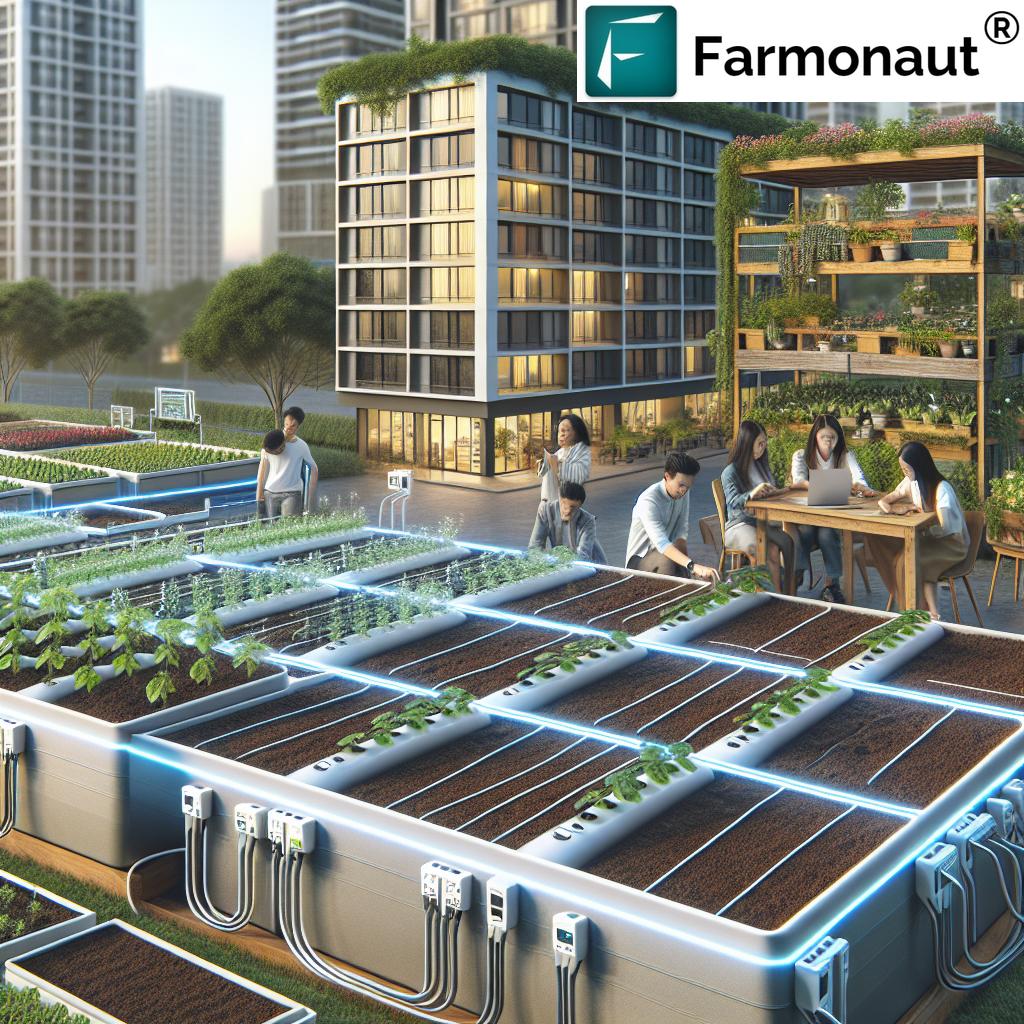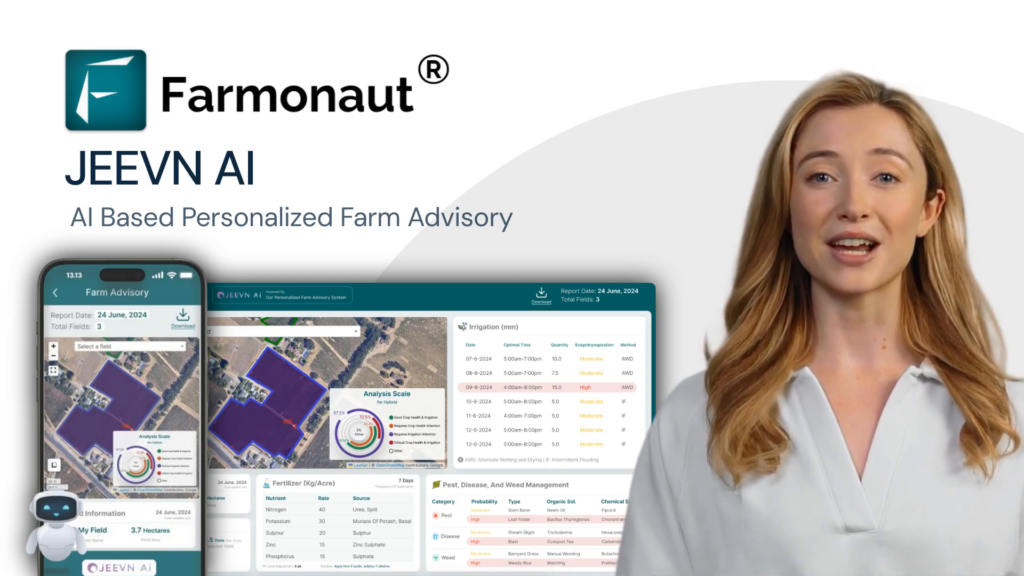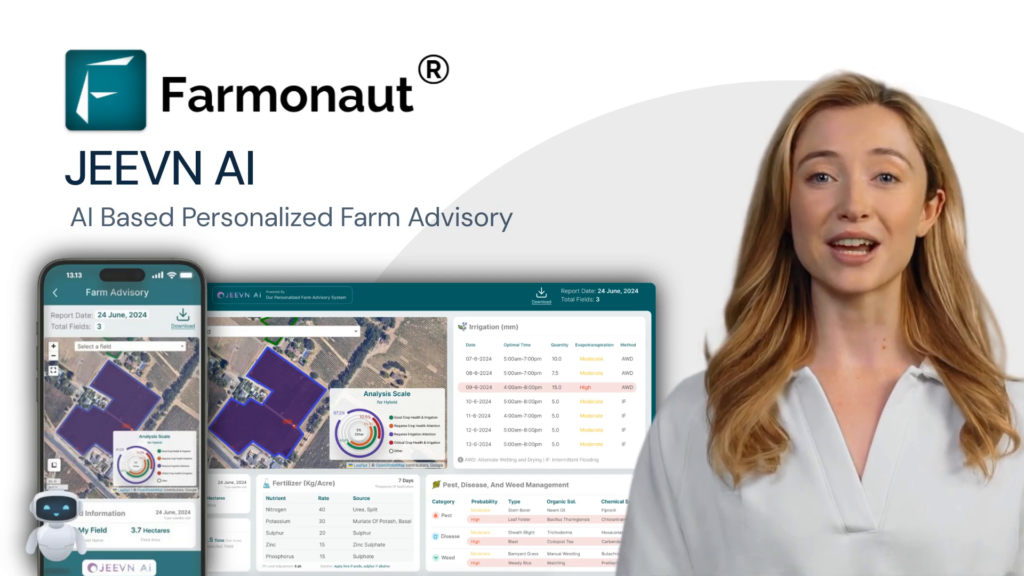Revolutionizing Urban Agriculture: Innovative Tech Solutions Transform Jackson’s Sustainable Farming Landscape
“Jackson’s urban agriculture project spans 22 acres, integrating modern workspaces, STEAM programs, and residential developments.”
Welcome to a groundbreaking journey through the heart of Jackson, Mississippi, where innovative urban agriculture technology is reshaping the landscape of sustainable farming. We’re excited to explore how this visionary project is not only transforming the local community but also setting a precedent for urban renewal across the nation.

In the bustling streets of Jackson, a remarkable transformation is underway. The Bean Path Tech District, spanning an impressive 22 acres, is at the forefront of this change, seamlessly blending modern workspaces, cutting-edge STEAM programs, and innovative residential developments. This initiative is not just about urban agriculture; it’s a comprehensive approach to community development that leverages agritech solutions to drive sustainable growth.
The Bean Path: A Catalyst for Change
At the heart of this urban renewal project is The Bean Path, a non-profit organization celebrating its sixth anniversary. Under the visionary leadership of Dr. Nashlie Sephus, this initiative has evolved into a vital hub for technology and community development. The Bean Path is more than just a tech incubator; it’s a beacon of hope for bridging the tech equity gap in farming and fostering agricultural workforce development.
Let’s delve into the key components that make this project a game-changer in urban agriculture:
- The Bean Barn: A modern workspace fostering collaboration and innovation
- Makers Space: Hosting activities from laser printing to computer technology workshops
- STEAM Programs: Engaging both youth and adults in technological education
- Residential Developments: Addressing Jackson’s critical housing needs
Innovative Farming Techniques Reshaping Urban Landscapes
The Bean Path Tech District is not just about buildings and programs; it’s a living laboratory for innovative farming techniques. By integrating cutting-edge soil and plant technology with community engagement, this project is setting new standards for urban agriculture.
Here are some of the groundbreaking technologies being implemented:
- Vertical Farming Systems: Maximizing space efficiency in urban environments
- IoT-based Soil Sensors: Providing real-time data on soil health and moisture levels
- Hydroponic Solutions: Enabling year-round crop production with minimal water usage
- AI-powered Crop Management: Optimizing plant growth and resource allocation
These innovative farming techniques are not just increasing food production; they’re creating a sustainable urban ecosystem that includes green spaces with trees and roof gardens. This holistic approach to urban agriculture is transforming Jackson into a model for smart city agriculture initiatives.
Bridging the Tech Equity Gap in Farming
One of the most significant aspects of this project is its focus on bridging the tech equity gap in farming. By making advanced agricultural technologies accessible to all community members, The Bean Path is democratizing access to precision agriculture solutions. This approach not only empowers local farmers but also creates new opportunities for agricultural workforce development.
Key initiatives in this area include:
- Free workshops on precision agriculture technologies
- Mentorship programs pairing experienced farmers with tech-savvy youth
- Collaborations with local schools to integrate agritech into STEAM curricula
These efforts are crucial in ensuring that the benefits of innovative urban agriculture technology reach all segments of the community, fostering inclusive growth and sustainable development.
The Impact of Precision Agriculture Solutions
Precision agriculture solutions are at the core of this urban renewal project. By leveraging advanced technologies, Jackson’s farmers are able to optimize resource use, increase crop yields, and minimize environmental impact. Let’s explore some of the key precision agriculture solutions being implemented:
- Satellite-Based Crop Monitoring: Utilizing remote sensing technology to assess crop health and predict yields
- Automated Irrigation Systems: Optimizing water usage based on real-time soil moisture data
- Drone Technology: Enabling precise application of fertilizers and pest control measures
- Data Analytics: Providing insights for informed decision-making in farm management
These precision agriculture solutions are not just improving farming efficiency; they’re also contributing to the overall sustainability of Jackson’s urban ecosystem. By reducing water waste, minimizing chemical inputs, and optimizing land use, these technologies are helping create a more environmentally friendly and resilient city.

Smart City Agriculture Initiatives: A Model for Urban Renewal
Jackson’s urban agriculture project is a prime example of how smart city agriculture initiatives can drive urban renewal. By integrating technology into every aspect of urban farming, from soil management to crop distribution, the city is creating a sustainable and resilient food system.
Key components of Jackson’s smart city agriculture initiatives include:
- Smart Sensors: Monitoring air quality, temperature, and humidity in urban farms
- Blockchain Technology: Ensuring transparency and traceability in the local food supply chain
- Community Engagement Apps: Connecting local farmers with consumers and facilitating direct sales
- Green Infrastructure: Incorporating living walls and rooftop gardens into urban design
These initiatives are not only enhancing food security but also creating green jobs, improving air quality, and fostering a sense of community around sustainable urban living.
The Role of Agritech in Community Development
Agritech is playing a pivotal role in Jackson’s community development, extending far beyond food production. The integration of agricultural technology into the urban fabric is creating new educational opportunities, fostering entrepreneurship, and strengthening community bonds.
Here’s how agritech is impacting various aspects of community life:
- Education: STEAM programs focused on agritech are preparing the next generation of innovators
- Economic Growth: New agritech startups are emerging, creating jobs and stimulating the local economy
- Community Engagement: Urban farms are becoming hubs for community gatherings and knowledge sharing
- Health and Wellness: Increased access to fresh, locally grown produce is improving community health outcomes
By leveraging agritech for community development, Jackson is not just growing food; it’s growing opportunities, relationships, and a sustainable future for its residents.
Sustainable Farming Innovations: A Closer Look
The sustainable farming innovations being implemented in Jackson are setting new standards for urban agriculture. These innovations are not only increasing food production but also ensuring that farming practices are environmentally friendly and resource-efficient.
Let’s explore some of the key sustainable farming innovations:
- Aquaponics Systems: Combining fish farming with hydroponic plant cultivation for a closed-loop system
- Biogas Production: Converting organic waste into renewable energy to power urban farms
- Rainwater Harvesting: Capturing and storing rainwater for irrigation, reducing reliance on municipal water supplies
- Pollinator-Friendly Practices: Integrating beekeeping and butterfly gardens to support urban biodiversity
These sustainable farming innovations are transforming Jackson into a model of urban resilience, demonstrating how cities can produce food locally while minimizing their environmental footprint.
“The initiative incorporates green spaces with trees and roof gardens, creating a sustainable urban ecosystem across the 22-acre site.”
The Green Infrastructure Revolution
One of the most visually striking aspects of Jackson’s urban agriculture project is its commitment to green infrastructure. The integration of trees, roof gardens, and other green spaces is not just aesthetically pleasing; it’s a crucial component of the city’s sustainable urban ecosystem.
Benefits of this green infrastructure include:
- Improved air quality and reduced urban heat island effect
- Enhanced stormwater management and flood prevention
- Increased biodiversity and wildlife habitat in urban areas
- Creation of relaxing green spaces for community recreation and well-being
By seamlessly blending agriculture with urban green spaces, Jackson is creating a living, breathing city that nurtures both its residents and the environment.
The Future of Urban Agriculture: Jackson’s Vision
As we look to the future, Jackson’s urban agriculture project provides a glimpse into what cities of tomorrow might look like. This visionary approach to innovative farming techniques is not just shaping the future of Jackson; it’s providing a blueprint for urban renewal that can be adapted and implemented in cities around the world.
Key elements of Jackson’s vision for the future of urban agriculture include:
- Fully integrated smart city systems that connect urban farms, consumers, and local businesses
- Expansion of vertical farming to transform unused urban spaces into productive agricultural zones
- Development of AI-driven predictive models for optimizing crop yields and resource allocation
- Creation of agricultural innovation hubs that foster collaboration between farmers, technologists, and researchers
By continuing to invest in and develop these innovative approaches, Jackson is positioning itself as a leader in the global movement towards sustainable, tech-driven urban agriculture.
Comparing Urban Agriculture Tech Solutions
To better understand the impact of various technologies being implemented in Jackson’s urban agriculture project, let’s take a closer look at how they compare:
| Technology Name | Primary Function | Estimated Implementation Cost | Potential Yield Increase | Environmental Impact Score (1-10) | Community Engagement Level |
|---|---|---|---|---|---|
| Vertical Farming Systems | Space-efficient crop production | $$$ | 300-400% | 9 | High |
| IoT-based Soil Sensors | Real-time soil health monitoring | $$ | 20-30% | 8 | Medium |
| Hydroponic Solutions | Water-efficient crop cultivation | $$$ | 200-300% | 9 | Medium |
| AI-powered Crop Management | Optimized resource allocation | $$$$ | 40-50% | 7 | Low |
| Rooftop Garden Technologies | Urban space utilization | $$ | 50-100% | 10 | High |
| Smart Irrigation Systems | Water conservation | $$ | 30-40% | 8 | Medium |
This comparison highlights the diverse range of technologies being employed in Jackson’s urban agriculture project, each contributing uniquely to the overall goal of creating a sustainable and productive urban farming ecosystem.
Empowering Farmers with Technology
One of the most significant aspects of Jackson’s urban agriculture revolution is the empowerment of local farmers through technology. By providing access to advanced tools and knowledge, the project is enabling farmers to transition from traditional methods to more efficient and sustainable practices.
Key ways technology is empowering farmers include:
- Access to real-time data for informed decision-making
- Reduced labor costs through automation of routine tasks
- Improved crop quality and yields through precision agriculture techniques
- Enhanced market access through digital platforms connecting farmers to consumers
This technological empowerment is not only improving the livelihoods of individual farmers but also contributing to the overall resilience and sustainability of Jackson’s food system.
The Role of Farmonaut in Urban Agriculture
As we explore the innovative technologies transforming Jackson’s urban agriculture landscape, it’s worth highlighting the contributions of companies like Farmonaut. While not directly involved in the Jackson project, Farmonaut’s advanced satellite-based farm management solutions align closely with the goals of urban agriculture initiatives.
Farmonaut offers a range of tools that could be valuable for urban farming projects:
- Satellite-Based Crop Health Monitoring: Providing real-time insights into vegetation health and soil moisture levels
- AI Advisory System: Delivering personalized farm management strategies
- Blockchain-Based Traceability: Ensuring transparency in urban food supply chains
- Carbon Footprint Tracking: Helping urban farms monitor and reduce their environmental impact
While Farmonaut is not directly involved in Jackson’s project, its technologies represent the kind of innovative solutions that are driving the future of urban agriculture worldwide.
Explore Farmonaut’s solutions:
The Economic Impact of Urban Agriculture
The transformation of Jackson through innovative urban agriculture is not just an environmental success story; it’s also driving significant economic growth. By creating new jobs, stimulating local businesses, and attracting investment, the project is revitalizing the city’s economy.
Key economic benefits include:
- Creation of green jobs in agriculture, technology, and related sectors
- Increased property values in areas surrounding urban farms and green spaces
- Boost to local food-related businesses, including restaurants and markets
- Attraction of eco-tourism, showcasing Jackson as a leader in sustainable urban development
This economic growth is creating a virtuous cycle, providing the resources needed to further expand and improve urban agriculture initiatives across the city.
Challenges and Solutions in Urban Agriculture
While Jackson’s urban agriculture project has achieved remarkable success, it hasn’t been without challenges. Addressing these obstacles has been crucial to the project’s ongoing success and provides valuable lessons for other cities looking to implement similar initiatives.
Some key challenges and their solutions include:
- Limited Space: Solved through vertical farming and creative use of underutilized urban areas
- Soil Contamination: Addressed with raised beds and hydroponic systems
- Water Scarcity: Mitigated through rainwater harvesting and efficient irrigation technologies
- Community Skepticism: Overcome through education programs and demonstration projects
By proactively addressing these challenges, Jackson has created a more resilient and adaptable urban agriculture system.
The Future of Food Security in Urban Areas
Jackson’s innovative approach to urban agriculture is not just about current needs; it’s laying the groundwork for long-term food security in urban areas. As cities worldwide grapple with population growth and climate change, the lessons learned from this project could prove invaluable.
Key aspects of Jackson’s approach to future food security include:
- Diversification of crop types to ensure a varied and nutritious local food supply
- Development of climate-resilient farming techniques to withstand extreme weather events
- Integration of urban agriculture into city planning and development policies
- Creation of community seed banks to preserve local plant varieties
By focusing on these long-term strategies, Jackson is not only securing its own food future but also providing a model for other cities to follow.
FAQs About Jackson’s Urban Agriculture Revolution
- Q: How has urban agriculture impacted Jackson’s food security?
A: Urban agriculture has significantly improved food security in Jackson by increasing local food production, reducing dependence on external sources, and improving access to fresh produce for all residents. - Q: What role does technology play in Jackson’s urban farming initiatives?
A: Technology is central to Jackson’s urban farming, with innovations like IoT sensors, AI-driven crop management, and vertical farming systems optimizing production and resource use. - Q: How is the community involved in these urban agriculture projects?
A: The community is deeply involved through educational programs, volunteer opportunities, and community-supported agriculture initiatives, fostering a sense of ownership and engagement. - Q: What environmental benefits has Jackson seen from urban agriculture?
A: Jackson has experienced improved air quality, reduced urban heat island effect, enhanced biodiversity, and more efficient water use as a result of urban agriculture initiatives. - Q: How is Jackson’s model of urban agriculture being shared with other cities?
A: Jackson is actively sharing its experiences through case studies, conferences, and collaborative partnerships with other cities interested in implementing similar urban agriculture programs.
Conclusion: A Green Revolution in the Heart of Jackson
As we conclude our exploration of Jackson’s urban agriculture revolution, it’s clear that this innovative project is more than just a local success story. It’s a beacon of hope for cities worldwide, demonstrating how innovative farming techniques, smart city agriculture initiatives, and community engagement can come together to create a more sustainable and resilient urban future.
From the green spaces of the Bean Path Tech District to the high-tech vertical farms transforming unused buildings, Jackson is writing a new chapter in the story of urban agriculture. By bridging the tech equity gap in farming, fostering agricultural workforce development, and implementing cutting-edge precision agriculture solutions, the city is not just growing food – it’s growing opportunities, communities, and a brighter future for all its residents.
As we look to the challenges facing our cities in the coming decades, from food security to climate change, Jackson’s model offers a powerful example of how innovation, technology, and community spirit can come together to create positive change. The seeds planted in Jackson today are growing into a sustainable tomorrow, not just for this vibrant Mississippi city, but for urban areas around the world.
















